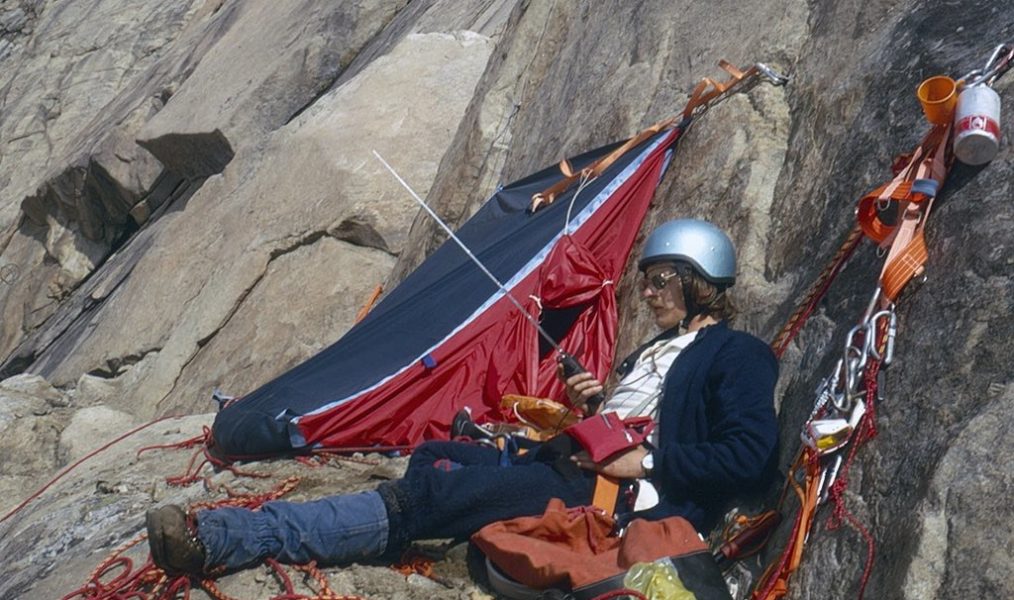Surviving in the mountains is perhaps as much about good luck or possibly ‘fate’ as good planning or experience and skill. Accident potential is always present and in these days of ever more apparent climate change, it’s getting ever trickier.
Past experience may no longer be enough to base sound decisions on. The recent avalanche deaths of experienced mountaineers are a warning to us all. Rock is also affected as sadly evidenced by the tragic deaths of two Czechs on the Troll Wall due to a massive rock fall in 2019. I’m told that Ice Age ice that previously bound the face is now melting at an increasing rate. The same thing is happening in the Alps and elsewhere. Athlyn Cathcart-Keays writes in her article, The Climate Crisis and the Future of Mountaineering, that “globally, 16 of the last 17 years have been the hottest ever recorded. In the high mountains, the impact of these changes is clearly visible. Glaciers, snow and ice are melting before our eyes. We’re seeing more sunny days, increased rockfall, shorter snow seasons and unseasonal temperatures.” Take care everyone.
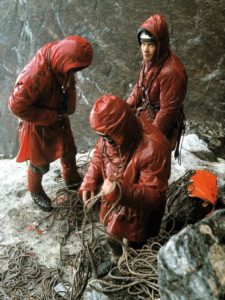
The author avoided being hit by a large rock on the Troll Wall in 1965
Though no matter how careful you are, it does indeed seem that luck quite often plays its part. It was simply down to good luck that during our Troll Wall climb back in 1965, a large rock hurtled through our tent not far from the route at a time when we were on the climb, and not in it! It would have wiped us out. And we were also incredibly lucky that on our second attempt, after five days of perfect weather on the wall, we reached the summit just hours before a thunderstorm heralded atrocious weather that lasted for days. A day later and we would have been dead. Similarly, as Emiliano Ardigò wrote recently, “In 1978 when Reinhold Messner made his solo ascent of the Diamir Face of Nanga Parbat, he pitched his tent 200 metres higher than originally planned. In doing so, he escaped the avalanche that would have otherwise swept him away. Was that simply down to luck – the famous ‘Fate’ deciding?”
Good luck or ‘Fate’ was also on my side in a Peak District winter when I was avalanched off the top of Dovestones Quarry by a collapsing moor edge cornice, only being saved because I went backwards over a small cliff, managing to land feet first and get my axes in as the avalanche roared past down the 50m cliff I had just climbed, failing to take me with it. A few years previously, also in Chew Valley, Graham West and Mick Roberts, two of the Peak District’s leading climbers, had been swept to their deaths by an unprecedented avalanche in Wilderness Gully. Two much less experienced lads lower down survived the fall. More recently a close friend of mine, Ernst Renner, a Swiss guide, was tragically killed on New Year’s Day 1979 on his home mountains. A huge avalanche from high up on the Pazzalastock near Andermatt killed him and his friend, Michael de Pret-Roose, Vice-President of the Ski Club of Great Britain, and two members of Michael’s family. Snow is fickle stuff.
As Robbie Burns rightly said, “The best laid plans o’ mice an’ men gang aft agley”. Which is what happened to us in Romsdal on the previously unclimbed 2000m East Pillar of Semletind adjacent to the Troll Wall in 1967. As I wrote in my autobiography, Quest into the Unknown, “We were half way up, moving together when, despite being midsummer, it started to snow. When we looked up, our summit and the headwall, somewhere high above were already concealed in cloud.
“Too late now to think of retreat – although visibility was minimal, we knew where we were going and soldiered on. With no shelter or bivy gear we needed to top out. We hurried on into increasingly heavy snow up the north side of the final 300m ridge. By now we had been swallowed by the descending clouds. Thunder rumbled overhead. A full-on winter storm in mid-summer was not on our agenda. Neither was a major rockfall. Lightning hit the cliff high above us, sending rocks thrumming like jagged cannon balls out of the clouds to explode around us with the smell of cordite. Bill Tweedale took a direct hit on his helmet, which was smashed. He hung limply and silently on the rope, unconscious. His face, which was streaming with blood from a gash in his head, was a ghastly shade of white. For a horrible moment, we thought he was dead, but he came round slowly. We suggested bivouacking until he recovered, but Bill, who always thrived in adversity, would have none of it, so we continued into the storm up the snow-covered cliff, finally emerging triumphantly, our first ascent in the bag, over the cornice into the blizzard and whiteout”, which also put our survival skills to the test.
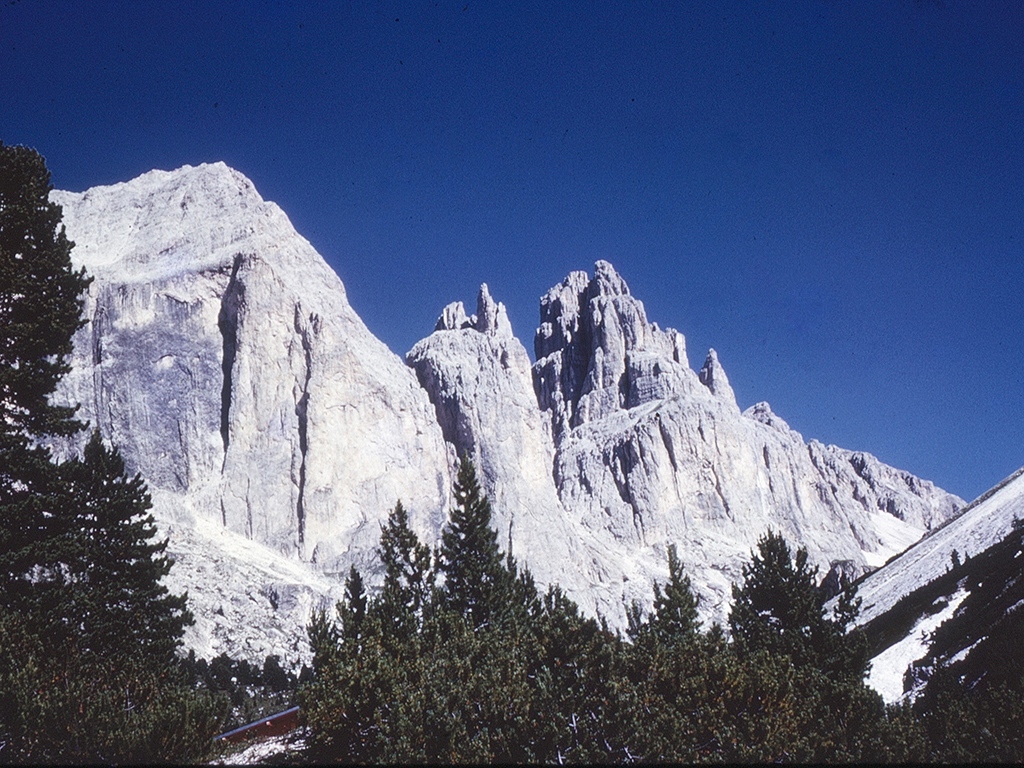
Blue-sky days in the Dolomites
Talking of weather, in the Dolomites I had previously experienced another blue sky day becoming a nightmare, this time on the East Wall of the Central Catinaccio when again a storm came from nowhere. Quoting from Quest again, “soon the first flash of blue dazzling lighting hit the face, apparently below us, accompanied by great crack of thunder. Keith Chadwick had jerked with the force of the electrical impulse passing through his body, whilst I was half-way up a pitch and clustered with buzzing ironmongery, unhappily aware of my situation.
The second flash came as I reached a small ledge and I shook involuntarily with the force of the electricity as the air reverberated around me with the deafening roar of thunder. It was followed immediately by the nerve wracking crash of tons of falling rock and I shrank under the poor security of the bulge in a desperate endeavour to mould myself into the rock and disappear under my helmet. The boulders crashed and fell in black whirling, screaming, whining masses only inches from my face; the air stank and dripped and I wondered how Keith was faring on the ledge below. He commented later in his inimitable style in the Rimmon Journal that “Lightning began to flash about. ‘Hurry up’, shouted ‘Oward. Flash bang! The lightning just missed my foot. Woosh, I went up like the clappers not bothering to look for holds. Crash! The lightning stuck again and a ton of rocks came past. ‘Guess what, that makes the route fifty foot shorter’, said ‘Oward in his usual amused tone”.
Over in the Alps, snow caused a problem for me and John Smith. Having topped out on Salbitschijen’s classic West Ridge, “we were on our way down when we reached the edge of a big fan of snow narrowing steeply down into a hidden couloir. John threw caution to the winds and jumped past me expecting to sink in a few inches but he didn’t. Under a thin covering of snow, it was ice, and he shot off down the slope, heading for the unseen couloir. The last I saw of him, having failed to dig his fingers and toes in, he was trying to force his elbows in as brakes, but nothing was working. He simply shot over the edge and disappeared. Then nothing. I shouted down but the mountain remained silent. I was sure he was dead.” If you want to know how that ended, it’s also in Quest.
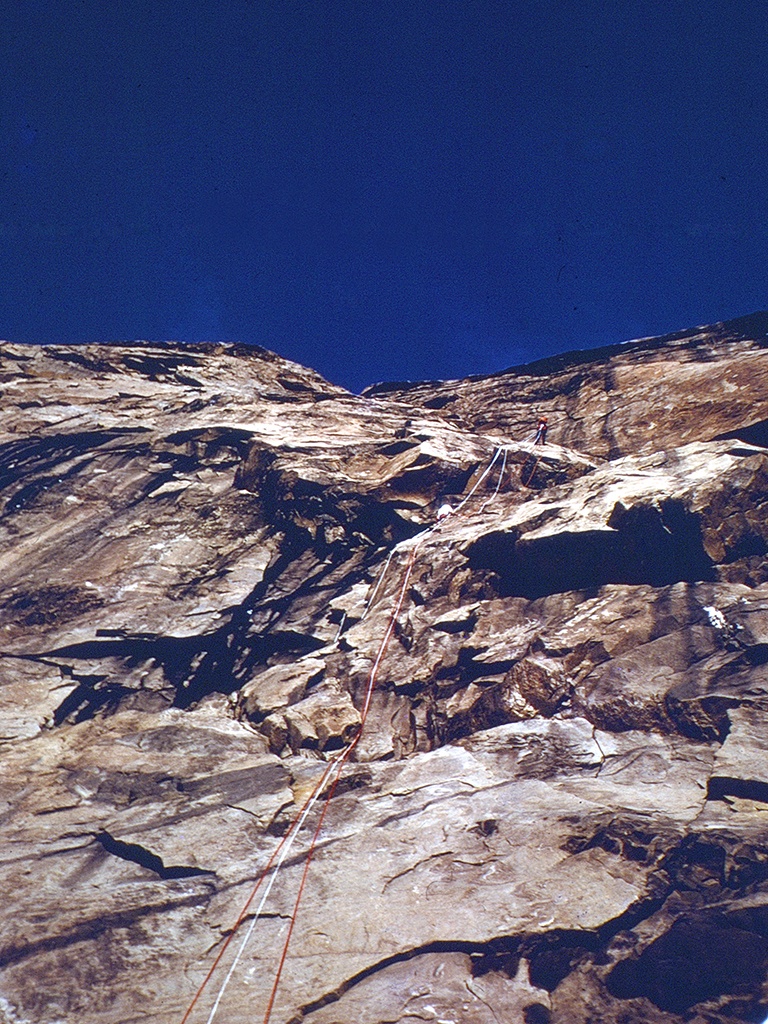
On the 2000m south face of Ingolffjeld in Greenland
Rock, of course, can also be dodgy stuff. As in another Quest story, “a third of the way up Greenland’s two thousand metre unclimbed South Face of Ingolffjeld “a huge tower at the top of the central pillar and a few hundred feet to our left detached itself from the summit, followed by a torrent of house-sized boulders. Bill and I watched in awe as the rocks fell, seemingly in slow motion. They were so far above us and to one side that we had no sense of imminent danger as they crashed down the opposite side of the amphitheatre and smashed against the wall, still half a mile above us. There, they exploded in a cloud of smoke, a thousand pieces of screaming shrapnel heading out across the wall in our direction. Suddenly, supremely aware of a sky filled with black death-dealing missiles, we watched, now in fear, intending to duck or dodge as each one whirled past. Increasing in size as they rushed downwards, it soon became only too obvious that there was nothing to do but curl up and wait. Decision made, we put our sacks, still full of gear, over our heads as the first rocks ricocheted off the walls above and around us. The air filled with dust and cordite. There were thuds and thumps as boulders and stones crashed on our ledge, jabs of pain on partly unprotected hunched shoulders and legs, then a receding rumble and the hiss of an avalanche in the couloir below, and it was over. The avalanche continued for half a mile out on to the glacier but stopped just before reaching our camp. The sky was thick with dust that settled slowly over the face and, from the wall below, only silence.
Was anybody hurt? We should have been dead. My leg throbbed from a bad bruise but otherwise I seemed unbelievably intact. Bill peered out from under his rucksack, still with a brew in his hand – the sack was in shreds, but he was in one piece. What of the others down below in the chimneys? Shouts were drifting up, all completely indecipherable. We got the walkie-talkie out and managed to contact Dolfi Rotovnik down on the glacier some distance away. The news came back, ‘Everyone okay.’”
Loose rock isn’t always obvious and whilst on new routes in the UK I have twice been dumped dangerously near the ground due to collapsing overhangs, once back in the ‘50s when a jammed knot runner and an attentive belayer stopped me just inches from the deck, and a few years later when my runner stopped me actually below ground level in a rock crevasse at the foot of the route. We called it Delilah as it was a fickle temptress. Even better, I was once exploring a route about fifty feet up when a hold broke – I jumped for some ivy which detached itself from the crag then slowly but obligingly peeled off the rock and lowered me to the ground to the great amusement of Di Taylor who was belaying me.
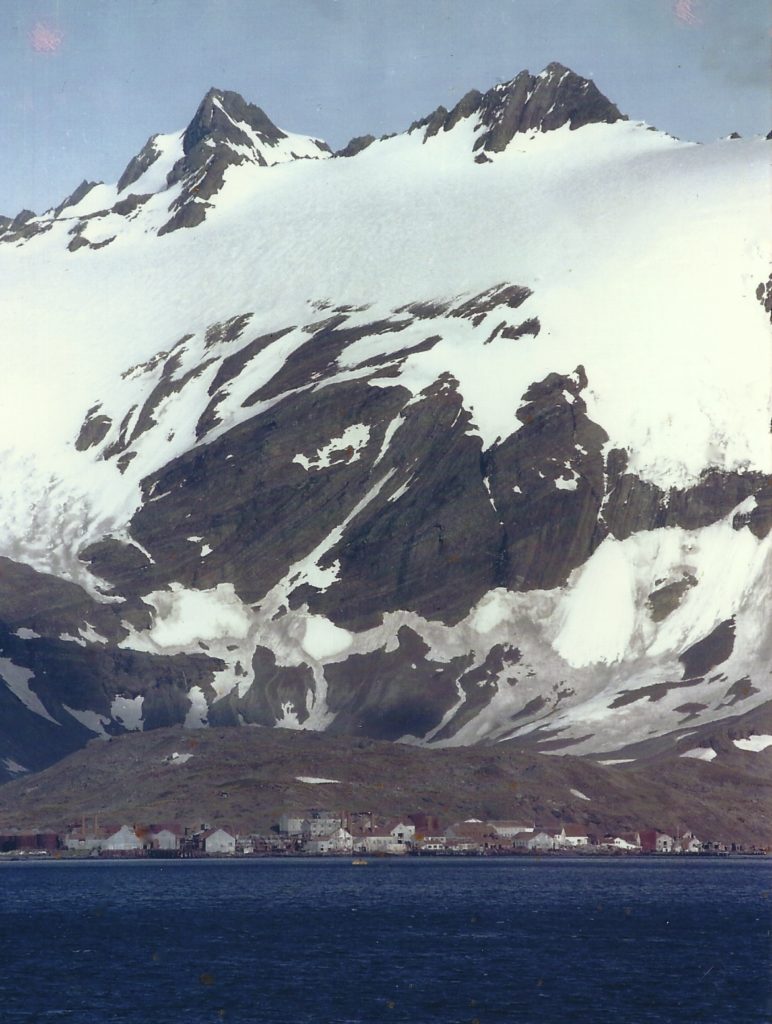
On expedition on South Georgia in 1958
Fate isn’t always so generous. As Peter Fimrite wrote in the Seattle Times in 2018, in his story about ‘The death plunge of two Yosemite climbers’, they were simul-climbing on El Cap with minimal pro when the leader fell ripping his runners and taking the second climber with him. Fimrite concluded, “They were just out to have a good time on a route they were familiar with. A lesson you hear a lot is, ‘Never let your guard down. … You can’t predict the things that will happen to you.’”
On a more cheerful note, I will conclude with a brief mention of another story from my ‘Quest’ book: one my earliest near death mountain experiences happened in South Georgia in 1958. I was alone, having been tempted to ‘have a look’ at my first glacier. Having successfully reached and crossed it’s bergschrund I climbed its headwall.The rock was actually collapsing but I made it up to the crumbling knife-edge ridge. “The view and feeling of isolation were unforgettable. The only trouble was, just what happened next? There was no way I was going on that face again”. Descending, I fell “helter-skelter, bottom-end down, straight towards the depths of who knows what. Those scree stones were sharp too. I remember thinking, ‘I’d better do something about this quick, or I’m a gonner’. As I reached the mouth of the bergschrund I pushed my legs out to bridge the gap. They just reached the lip of the glacier on the other side and I jammed myself across the crevasse. Stones rattled on into the icy blackness. Then all was silent. Laughing with relief, I decided that if I ever got down I’d give climbing up immediately.”
I never did stop climbing, but I did learn a useful lesson: Fate sometimes favours the foolish. Or, as an old friend of mine often says, in my case, it’s just “‘Oward’s luck”!
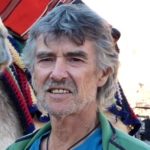 Tony Howard is a climber, adventurer, gear designer and author who is best known for the first British ascent of the Troll Wall in 1965, for inventing the modern sit harness, and for pioneering the Jordan Trail in the Middle East. He is the author of Troll Wall https://www.v-publishing.co.uk/books/narratives/troll-wall.html and Quest into the Unknown https://www.v-publishing.co.uk/books/narratives/quest-into-the-unknown.html and climbing and trekking guidebooks to UK, Norway, Jordan and Palestine.
Tony Howard is a climber, adventurer, gear designer and author who is best known for the first British ascent of the Troll Wall in 1965, for inventing the modern sit harness, and for pioneering the Jordan Trail in the Middle East. He is the author of Troll Wall https://www.v-publishing.co.uk/books/narratives/troll-wall.html and Quest into the Unknown https://www.v-publishing.co.uk/books/narratives/quest-into-the-unknown.html and climbing and trekking guidebooks to UK, Norway, Jordan and Palestine.
Surviving in the mountains is perhaps as much about good luck or possibly ‘fate’ as good planning or experience and skill. Accident potential is always present and in these days of ever more apparent climate change, it’s getting ever trickier.
Past experience may no longer be enough to base sound decisions on. The recent avalanche deaths of experienced mountaineers are a warning to us all. Rock is also affected as sadly evidenced by the tragic deaths of two Czechs on the Troll Wall due to a massive rock fall in 2019. I’m told that Ice Age ice that previously bound the face is now melting at an increasing rate. The same thing is happening in the Alps and elsewhere. Athlyn Cathcart-Keays writes in her article, The Climate Crisis and the Future of Mountaineering, that “globally, 16 of the last 17 years have been the hottest ever recorded. In the high mountains, the impact of these changes is clearly visible. Glaciers, snow and ice are melting before our eyes. We’re seeing more sunny days, increased rockfall, shorter snow seasons and unseasonal temperatures.” Take care everyone.

The author avoided being hit by a large rock on the Troll Wall in 1965
Though no matter how careful you are, it does indeed seem that luck quite often plays its part. It was simply down to good luck that during our Troll Wall climb back in 1965, a large rock hurtled through our tent not far from the route at a time when we were on the climb, and not in it! It would have wiped us out. And we were also incredibly lucky that on our second attempt, after five days of perfect weather on the wall, we reached the summit just hours before a thunderstorm heralded atrocious weather that lasted for days. A day later and we would have been dead. Similarly, as Emiliano Ardigò wrote recently, “In 1978 when Reinhold Messner made his solo ascent of the Diamir Face of Nanga Parbat, he pitched his tent 200 metres higher than originally planned. In doing so, he escaped the avalanche that would have otherwise swept him away. Was that simply down to luck – the famous ‘Fate’ deciding?”
Good luck or ‘Fate’ was also on my side in a Peak District winter when I was avalanched off the top of Dovestones Quarry by a collapsing moor edge cornice, only being saved because I went backwards over a small cliff, managing to land feet first and get my axes in as the avalanche roared past down the 50m cliff I had just climbed, failing to take me with it. A few years previously, also in Chew Valley, Graham West and Mick Roberts, two of the Peak District’s leading climbers, had been swept to their deaths by an unprecedented avalanche in Wilderness Gully. Two much less experienced lads lower down survived the fall. More recently a close friend of mine, Ernst Renner, a Swiss guide, was tragically killed on New Year’s Day 1979 on his home mountains. A huge avalanche from high up on the Pazzalastock near Andermatt killed him and his friend, Michael de Pret-Roose, Vice-President of the Ski Club of Great Britain, and two members of Michael’s family. Snow is fickle stuff.
As Robbie Burns rightly said, “The best laid plans o’ mice an’ men gang aft agley”. Which is what happened to us in Romsdal on the previously unclimbed 2000m East Pillar of Semletind adjacent to the Troll Wall in 1967. As I wrote in my autobiography, Quest into the Unknown, “We were half way up, moving together when, despite being midsummer, it started to snow. When we looked up, our summit and the headwall, somewhere high above were already concealed in cloud.
“Too late now to think of retreat – although visibility was minimal, we knew where we were going and soldiered on. With no shelter or bivy gear we needed to top out. We hurried on into increasingly heavy snow up the north side of the final 300m ridge. By now we had been swallowed by the descending clouds. Thunder rumbled overhead. A full-on winter storm in mid-summer was not on our agenda. Neither was a major rockfall. Lightning hit the cliff high above us, sending rocks thrumming like jagged cannon balls out of the clouds to explode around us with the smell of cordite. Bill Tweedale took a direct hit on his helmet, which was smashed. He hung limply and silently on the rope, unconscious. His face, which was streaming with blood from a gash in his head, was a ghastly shade of white. For a horrible moment, we thought he was dead, but he came round slowly. We suggested bivouacking until he recovered, but Bill, who always thrived in adversity, would have none of it, so we continued into the storm up the snow-covered cliff, finally emerging triumphantly, our first ascent in the bag, over the cornice into the blizzard and whiteout”, which also put our survival skills to the test.

Blue-sky days in the Dolomites
Talking of weather, in the Dolomites I had previously experienced another blue sky day becoming a nightmare, this time on the East Wall of the Central Catinaccio when again a storm came from nowhere. Quoting from Quest again, “soon the first flash of blue dazzling lighting hit the face, apparently below us, accompanied by great crack of thunder. Keith Chadwick had jerked with the force of the electrical impulse passing through his body, whilst I was half-way up a pitch and clustered with buzzing ironmongery, unhappily aware of my situation.
The second flash came as I reached a small ledge and I shook involuntarily with the force of the electricity as the air reverberated around me with the deafening roar of thunder. It was followed immediately by the nerve wracking crash of tons of falling rock and I shrank under the poor security of the bulge in a desperate endeavour to mould myself into the rock and disappear under my helmet. The boulders crashed and fell in black whirling, screaming, whining masses only inches from my face; the air stank and dripped and I wondered how Keith was faring on the ledge below. He commented later in his inimitable style in the Rimmon Journal that “Lightning began to flash about. ‘Hurry up’, shouted ‘Oward. Flash bang! The lightning just missed my foot. Woosh, I went up like the clappers not bothering to look for holds. Crash! The lightning stuck again and a ton of rocks came past. ‘Guess what, that makes the route fifty foot shorter’, said ‘Oward in his usual amused tone”.
Over in the Alps, snow caused a problem for me and John Smith. Having topped out on Salbitschijen’s classic West Ridge, “we were on our way down when we reached the edge of a big fan of snow narrowing steeply down into a hidden couloir. John threw caution to the winds and jumped past me expecting to sink in a few inches but he didn’t. Under a thin covering of snow, it was ice, and he shot off down the slope, heading for the unseen couloir. The last I saw of him, having failed to dig his fingers and toes in, he was trying to force his elbows in as brakes, but nothing was working. He simply shot over the edge and disappeared. Then nothing. I shouted down but the mountain remained silent. I was sure he was dead.” If you want to know how that ended, it’s also in Quest.

On the 2000m south face of Ingolffjeld in Greenland
Rock, of course, can also be dodgy stuff. As in another Quest story, “a third of the way up Greenland’s two thousand metre unclimbed South Face of Ingolffjeld “a huge tower at the top of the central pillar and a few hundred feet to our left detached itself from the summit, followed by a torrent of house-sized boulders. Bill and I watched in awe as the rocks fell, seemingly in slow motion. They were so far above us and to one side that we had no sense of imminent danger as they crashed down the opposite side of the amphitheatre and smashed against the wall, still half a mile above us. There, they exploded in a cloud of smoke, a thousand pieces of screaming shrapnel heading out across the wall in our direction. Suddenly, supremely aware of a sky filled with black death-dealing missiles, we watched, now in fear, intending to duck or dodge as each one whirled past. Increasing in size as they rushed downwards, it soon became only too obvious that there was nothing to do but curl up and wait. Decision made, we put our sacks, still full of gear, over our heads as the first rocks ricocheted off the walls above and around us. The air filled with dust and cordite. There were thuds and thumps as boulders and stones crashed on our ledge, jabs of pain on partly unprotected hunched shoulders and legs, then a receding rumble and the hiss of an avalanche in the couloir below, and it was over. The avalanche continued for half a mile out on to the glacier but stopped just before reaching our camp. The sky was thick with dust that settled slowly over the face and, from the wall below, only silence.
Was anybody hurt? We should have been dead. My leg throbbed from a bad bruise but otherwise I seemed unbelievably intact. Bill peered out from under his rucksack, still with a brew in his hand – the sack was in shreds, but he was in one piece. What of the others down below in the chimneys? Shouts were drifting up, all completely indecipherable. We got the walkie-talkie out and managed to contact Dolfi Rotovnik down on the glacier some distance away. The news came back, ‘Everyone okay.’”
Loose rock isn’t always obvious and whilst on new routes in the UK I have twice been dumped dangerously near the ground due to collapsing overhangs, once back in the ‘50s when a jammed knot runner and an attentive belayer stopped me just inches from the deck, and a few years later when my runner stopped me actually below ground level in a rock crevasse at the foot of the route. We called it Delilah as it was a fickle temptress. Even better, I was once exploring a route about fifty feet up when a hold broke – I jumped for some ivy which detached itself from the crag then slowly but obligingly peeled off the rock and lowered me to the ground to the great amusement of Di Taylor who was belaying me.

On expedition on South Georgia in 1958
Fate isn’t always so generous. As Peter Fimrite wrote in the Seattle Times in 2018, in his story about ‘The death plunge of two Yosemite climbers’, they were simul-climbing on El Cap with minimal pro when the leader fell ripping his runners and taking the second climber with him. Fimrite concluded, “They were just out to have a good time on a route they were familiar with. A lesson you hear a lot is, ‘Never let your guard down. … You can’t predict the things that will happen to you.’”
On a more cheerful note, I will conclude with a brief mention of another story from my ‘Quest’ book: one my earliest near death mountain experiences happened in South Georgia in 1958. I was alone, having been tempted to ‘have a look’ at my first glacier. Having successfully reached and crossed it’s bergschrund I climbed its headwall.The rock was actually collapsing but I made it up to the crumbling knife-edge ridge. “The view and feeling of isolation were unforgettable. The only trouble was, just what happened next? There was no way I was going on that face again”. Descending, I fell “helter-skelter, bottom-end down, straight towards the depths of who knows what. Those scree stones were sharp too. I remember thinking, ‘I’d better do something about this quick, or I’m a gonner’. As I reached the mouth of the bergschrund I pushed my legs out to bridge the gap. They just reached the lip of the glacier on the other side and I jammed myself across the crevasse. Stones rattled on into the icy blackness. Then all was silent. Laughing with relief, I decided that if I ever got down I’d give climbing up immediately.”
I never did stop climbing, but I did learn a useful lesson: Fate sometimes favours the foolish. Or, as an old friend of mine often says, in my case, it’s just “‘Oward’s luck”!
 Tony Howard is a climber, adventurer, gear designer and author who is best known for the first British ascent of the Troll Wall in 1965, for inventing the modern sit harness, and for pioneering the Jordan Trail in the Middle East. He is the author of Troll Wall https://www.v-publishing.co.uk/books/narratives/troll-wall.html and Quest into the Unknown https://www.v-publishing.co.uk/books/narratives/quest-into-the-unknown.html and climbing and trekking guidebooks to UK, Norway, Jordan and Palestine.
Tony Howard is a climber, adventurer, gear designer and author who is best known for the first British ascent of the Troll Wall in 1965, for inventing the modern sit harness, and for pioneering the Jordan Trail in the Middle East. He is the author of Troll Wall https://www.v-publishing.co.uk/books/narratives/troll-wall.html and Quest into the Unknown https://www.v-publishing.co.uk/books/narratives/quest-into-the-unknown.html and climbing and trekking guidebooks to UK, Norway, Jordan and Palestine.


